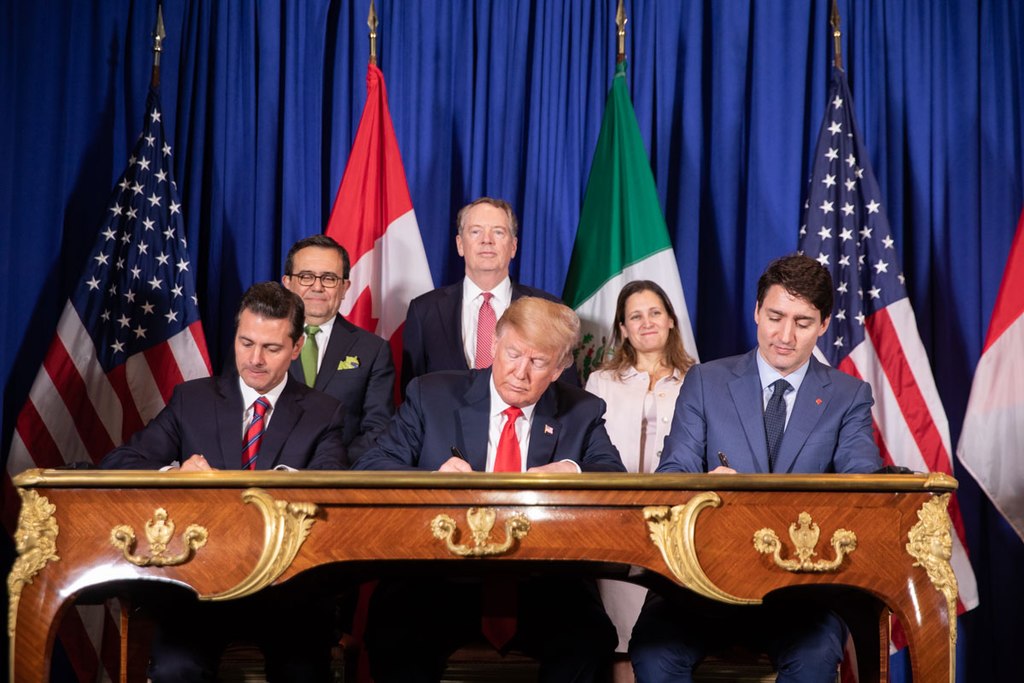 "United States-Mexico-Canada Agreement", Wikipedia
"United States-Mexico-Canada Agreement", Wikipedia
Streamlined Trade, Broadened Collaboration: USMCA’s Promise for National Security
Amidst a global pandemic that has shaken world economies and quarantined millions of citizens, a trilateral free trade agreement to further integrate North America quietly entered into effect on July 1st, 2020. A modernized version of the 1994 North American Free Trade Agreement (“NAFTA”), the United States-Mexico-Canada Agreement (“USMCA”) covers agricultural and industrial goods as well as digital property. Its implementation was met with bipartisan support in America: Democratic and Republican leaders uniformly acknowledged the importance of updating NAFTA for the 21st century.
USMCA Overview
USMCA tightens certain NAFTA-era regulations on labor rights and percent-origin rules for multilaterally traded goods. However, pundits have already pointed out one possible weakness: limited job retraining programs and limited funding for such programs. This oversight has the potential to harm low-wage workers whose local industries will be out-competed by free-trade goods. Additionally, USMCA does not smooth over all tensions between the three trading partners; the U.S. was in the middle of debating tariffs on Canadian aluminum shortly before USMCA was ratified.
Despite the minor shortcomings identified, USMCA’s content fortifies three branches of American national security: economic security, energy security, and diplomatic security. In doing so, the agreement lays the foundations for American energy independence, economic competitiveness, and geopolitical rivalry with China to an extent that NAFTA did not envision.
Economic Security and USMCA
First, USMCA fortifies economic security by strengthening supply chain stability. Congressman Henry Cuellar of Texas, a key proponent of USMCA, held a celebratory call with statewide business associations to celebrate the agreement’s implementation. On the call, a Texas industry representative emphasized that Texas and Mexico were in communication to make sure supply chains were not interrupted, even during COVID-19. Additionally, the three countries of the agreement have a 2-3 year grace period to fully implement USMCA conditions, and over this time supply part requirements would “boost demand and strengthen the regional supply chain”. USMCA further enhances supply chain stability by opening up new markets for goods, particularly between the U.S. and Canada since the U.S. now has access to the Canadian dairy market.
Energy Security and USMCA
The second USMCA-national security tie is through energy security. The United States has historically seen energy independence, i.e. reducing reliance on partner countries that can withhold critical resources, as a key marker of national security. Both Mexico and Canada have well-developed oil industries, which USMCA further integrates with their American counterpart. When NAFTA was signed in 1994, Mexico’s state-owned oil giant Pemex was effectively closed to foreign investment. In 2013, political reforms in Mexico opened up the energy sector to international companies, as well as joint ventures between these companies and Pemex. USMCA codifies these modifications into the agreement, which protects foreign investors and increases the flows of crude oil, natural gas, refined product, and petrochemicals. In addition to oil, another key energy resource covered by USMCA is liquified natural gas (“LNG”). A fact sheet from the Office of the U.S. Trade Representative confirms that U.S. LNG exports to Mexico and Canada will receive automatic approval for export under USMCA.
Beyond guaranteeing access to raw materials for energy security, USMCA also standardizes energy-related infrastructure and regulatory systems across countries. It borrows from NAFTA’s former incentives to promote cross-border pipelines and provides reduced tariff rates to inputs like steel that compose this infrastructure. Meanwhile, USMCA preserves a crucial energy-related clause from NAFTA: the investor dispute settlement mechanism (ISDS) from Ch. 11. Recent events suggest this mechanism may be used in the near future: the main U.S. oil and gas lobby complained that recent actions by the Mexican government in favor of Pemex “violated USMCA’s protections for private investors”. Canadian authorities also voiced concerns about Mexican rules regarding investment in renewable energy.
Diplomatic Security and USMCA
The third and final USMCA-national security tie is through diplomatic security. USMCA addresses this through pro-labor clauses directed at Mexican unions and anti-China provisions. One of the most commented-on parts of USMCA is its predicted boost to the autonomy and bargaining power of Mexican unions. By fortifying the civil society of an important ally, the US is investing in diplomatic security through USMCA. USMCA also addresses American national security by denying China preferential trading status with Canada and Mexico. In fact, Section 10, Clause 32 of the USMCA allows signatories to pull out if one country pursues a separate free trade agreement with a “nonmarket country”—which experts agreed referred to China. Competition with China, particularly in the automaking sector, was a trait of NAFTA as well.
Projected Outcomes
After considering USMCA’s relationship with three dimensions of national security: economic security; energy security; and diplomatic security, the agreement will strengthen national security in the long run. In stabilizing American access to agricultural markets and energy sources, USMCA deepens America’s resource independence. USMCA also sets the groundwork for future bilateral or trilateral cooperation in other fields by building goodwill among key partner countries. This is particularly relevant for intelligence sharing between the U.S. and Mexico in counter-narcotics operations. These high hopes set the opening scene for the next years of USMCA implementation, yet whether the agreement can live up to its full potential remains to be seen.





